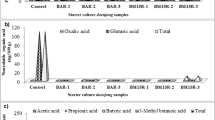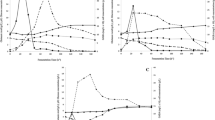Abstract
Fermented soybean products may contain aflatoxins due to the contamination of the aflatoxin producing mold during natural fermentation or as a result of un-prudential use of starter strain. The aim of the present study was to develop and characterize fermented soybean products with enhanced safety and bioactive compound using aflatoxin non-producing Aspergillus oryzae FMB S46471 and γ-aminobutyric acid (GABA) producing Lactobacillus brevis GABA 100. For fermentation, steam-processed soybeans were inoculated with A. oryzae FMB S46471. The scaled-up fermentation product was fermented for 17 days, including 12 days fermentation with A. oryzae and 5 days with L. brevis, and contained 6.5±0.3 g/kg of GABA and 45.7±0.3 g/kg of total free amino acids. After ripening for 90 days, the fermented soybean contained about 11.6±0.3 g/kg of GABA and 72.7±1.8 g/kg of total free amino acids. Furthermore, aflatoxins were not detected in both mature and immature soybean products. The soybean product that fermented by an aflatoxin non-producer and a powerful GABA producer will contribute to the development of fermented foods with enhanced safety levels and functional benefits of GABA.
Similar content being viewed by others
References
Coda R, Rizzello CG, and Gobbetti M (2010) Use of sourdough fermentation and pseudo-cereals and leguminous flours for the making of a functional bread enriched of gamma aminobutyric acid (GABA). Int J Food Microbiol 137, 236–45.
Dhakal R, Bajpai VK, and Baek KH (2012) Production of gaba (γ-Aminobutyric acid) by microorganisms: a review. Braz J Microbiol 43, 1230–41.
Di Cagno R, Mazzacane F, Rizzello CG, De Angelis M, Giuliani G, Meloni M, De Servi B, and Gobbetti M (2010) Synthesis of gammaaminobutyric acid (GABA) by Lactobacillus plantarum DSM19463: functional grape must beverage and dermatological applications. Appl microbiol biotechnol 86, 731–41.
Inoue K, Shirai T, Ochiai H, Kasao M, Hayakawa K, Kimura M, and Sansawa H (2003) Blood-pressure-lowering effect of a novel fermented milk containing gamma-aminobutyric acid (GABA) in mild hypertensives. Eur J Clin Nutr 57, 490–5.
Jo SJ, Hong CO, Yang SY, Choi KK, Kim HK, Yang H, and Lee KW (2011) Changes in Contents of γ-Aminobutyric Acid (GABA) and Isoflavones in Traditional Korean Doenjang by Ripening Periods. J Korean Soc Food Sci Nutr 40, 557–64.
Kim DM, Chung SH, and Chun HS (2011) Multiplex PCR assay for the detection of aflatoxigenic and non-aflatoxigenic fungi in meju, a Korean fermented soybean food starter. Food Microbiol 28, 1402–8.
Kim EK, Shon DH, Yoo JY, Ryu D, Lee C, and Kim YB (2001) Natural occurrence of aflatoxins in Korean meju. Food Addit Contam 18, 151–6.
Kim JA, Park MS, Kang SA, and Ji GE (2014a) Production of γ-aminobutyric acid during fermentation of Gastrodia elata Bl. by co-culture of Lactobacillus brevis GABA 100 with Bifidobacterium bifidum BGN4. Food Sci Biotechnol 23, 459–66.
Kim JY, Lee MY, Ji GE, Lee YS, and Hwang KT (2009) Production of gamma-aminobutyric acid in black raspberry juice during fermentation by Lactobacillus brevis GABA100. Int J Food Microbiol 130, 12–6.
Kim NY, Lee JH, Lee IH, and Ji GE (2014b) An evaluation of aflatoxin and cyclopiazonic acid production in Aspergillus oryzae. J Food Prot 77, 1010–6.
Kitamoto K (2002) Molecular biology of the Koji molds. Adv Appl Microbiol 51, 129–53.
Kono I and Himeno K (2000) Changes in gamma-aminobutyric acid content during beni-koji making. Biosci Biotechnol Biochem 64, 617–9.
Korea Food and Drug Administration (2008) Korea Foods Industry Association. Food Code, Korea.
Korea Food and Drug Administration (2009) Functional ingredients for human health. Korea.
Kunitz M (1974) Crystalline soybean trypsin inhibitor. J Gen Physiol 30, 291–351.
Lee BJ, Kim JS, Kang YM, Lim JH, Kim YM, Lee MS, Jeong MH, Ahn CB, and Je JY (2010) Antioxidant activity and ã-aminobutyric acid (GABA) content in sea tangle fermented by Lactobacillus brevis BJ20 isolated from traditional fermented foods. Food Chem 122, 271–6.
Lee CH and Lee SS (2002) Cereal fermentation by fungi. Appl Mycol Biotechnol 2, 151–70.
Lee GI, Lee HM, and Lee CH (2012) Food safety issues in industrialization of traditional Korean foods. Food Control 24, 1–5.
Lee YJ, Kim JE, Kwak MH, Go J, Kim DS, Son HJ et al. (2014) Quantitative evaluation of the therapeutic effect of fermented soybean products containing a high concentration of GABA on phthalic anhydride-induced atopic dermatitis in IL-4/Luc/CNS-1 Tg mice. Int J Mol Med 33, 1185–94.
Li H and Cao Y (2010) Review Lactic acid bacterial cell factories for gammaaminobutyric acid. Amino Acids 39, 1107–16.
Li H, Gao D, Cao Y, and Xu H (2008) A high γ-aminobutyric acid-producing Lactobacillus brevis isolated from Chinese traditional paocai. Ann Microbiol 58, 649–53.
Lu X, Xie C, and Gu Z (2008) Isolation of γ-aminobutyric acid-producing bacteria and optimization of fermentative medium. Biochem Eng J 41, 48–52.
Marin S, Ramos AJ, Cano-Sancho G, and Sanchis V (2013) Mycotoxins: occurrence, toxicology, and exposure assessment. Food Chem Toxicol 60, 218–37.
Miura D, Ito Y, Mizukuchi A, Kise M, Aoto H, and Yagasaki K (2006) Hypocholesterolemic action of pre-germinated brown rice in hepatomabearing rats. Life Sci 79, 259–64.
Nomura M, Kimoto H, Someya Y, Furukawa S, and Suzuki I (1998) Production of gamma-aminobutyric acid by cheese starters during cheese ripening. J Dairy Sci 81, 1486–91.
Park JH, Kang SJ, Oh SS, and Chung DH (2001) The screening of aflatoxin producing fungi from commercial meju and soybean paste in western Gyeongnam by immunoassay. J Food Hyg Safety 16, 274–9.
Park KB and Oh SH (2006) Isolation and characterization of Lactobacillus buchneri strains with high gamma-aminobutyric acid producing capacity from naturally aged cheese. Food Sci Biotechnol 15, 86–90.
Park KB and Oh SH (2007) Production of yogurt with enhanced levels of gamma-aminobutyric acid and valuable nutrients using lactic acid bacteria and germinated soybean extract. Bioresour Technol 98, 1675–9.
Rizzello CG, Cassone A, Di Cagno R, and Gobbetti M (2008) Synthesis of angiotensin I-converting enzyme (ACE)-inhibitory peptides and gammaaminobutyric acid (GABA) during sourdough fermentation by selected lactic acid bacteria. J Agric Food Chem 56, 6936–43.
Seok JH, Park KB, Kim YH, Bae MO, Lee MK, and Oh SH (2008) Production and characterization of kimchi with enhanced levels of gamma-aminobutyric acid. Food Sci Technol 17, 940–6.
Siragusa S, De Angelis M, Di Cagno R, Rizzello CG, Coda R, and Gobbetti M (2007) Synthesis of gamma-aminobutyric acid by lactic acid bacteria isolated from a variety of Italian cheeses. Appl Environ Microbiol 73, 7283–90.
Smith DK, Kassam T, Singh B, and Elliott JF (1992) Escherichia coli has two homologous glutamate decarboxylase genes that map to distinct loci. J Bacteriol 174, 5820–6.
Takeshima K, Yamatsu A, Yamashita Y, Watabe K, Horie N, Masuda K, and Kim M (2014) Subchronic toxicity evaluation of ã-aminobutyric acid (GABA) in rats. Food Chem. Toxicol 68, 128–34.
Tamang JP and Samuel D (2010) Dietary cultures and antiquity of fermented foods and beverages. In Fermented foods and beverages of the world, Tamang JP and Kailasapathy K (eds.), pp. 1–40, CRC press Inc., USA.
Tsai JS, Lin YS, Pan BS, and Chen TJ (2006) Antihypertensive peptides and gamma-aminobutyric acid from prozyme 6 facilitated lactic acid bacteria fermentation of soymilk. Process Biochem 41, 1282–8.
Ueno H (2000) Enzymatic and structural aspects on glutamate decarboxylase. J Mol Catal B-Enzym 10, 67–79.
Wichamanee Y and Teerarat I (2012) Production of germinated Red Jasmine brown rice and its physicochemical properties. Int Food R J 19, 1649–54.
Xie F, Lai W, Saini J, Shan S, Cui X, and Liu D (2014) Rapid pretreatment and detection of trace aflatoxin B1 in traditional soybean sauce. Food Chem 150, 99–105.
Yokoyama S, Hiramatsu J, and Hayakawa K (2002) Production of gammaaminobutyric acid from alcohol distillery lees by Lactobacillus brevis IFO-12005. J Biosci Bioeng 93, 95–7.
Zhang H, Yao HY, and Chen F (2006) Accumulation of gamma aminobutyric acid in rice germ using protease. Biosci Biotechnol Biochem 70, 1160–5.
Author information
Authors and Affiliations
Corresponding author
Electronic supplementary material
Rights and permissions
About this article
Cite this article
Kim, N.Y., Ji, G.E. Characterization of soybean fermented by aflatoxin non-producing Aspergillus oryzae and γ-aminobutyric acid producing Lactobacillus brevis . J Korean Soc Appl Biol Chem 57, 703–708 (2014). https://doi.org/10.1007/s13765-014-4227-5
Received:
Accepted:
Published:
Issue Date:
DOI: https://doi.org/10.1007/s13765-014-4227-5




